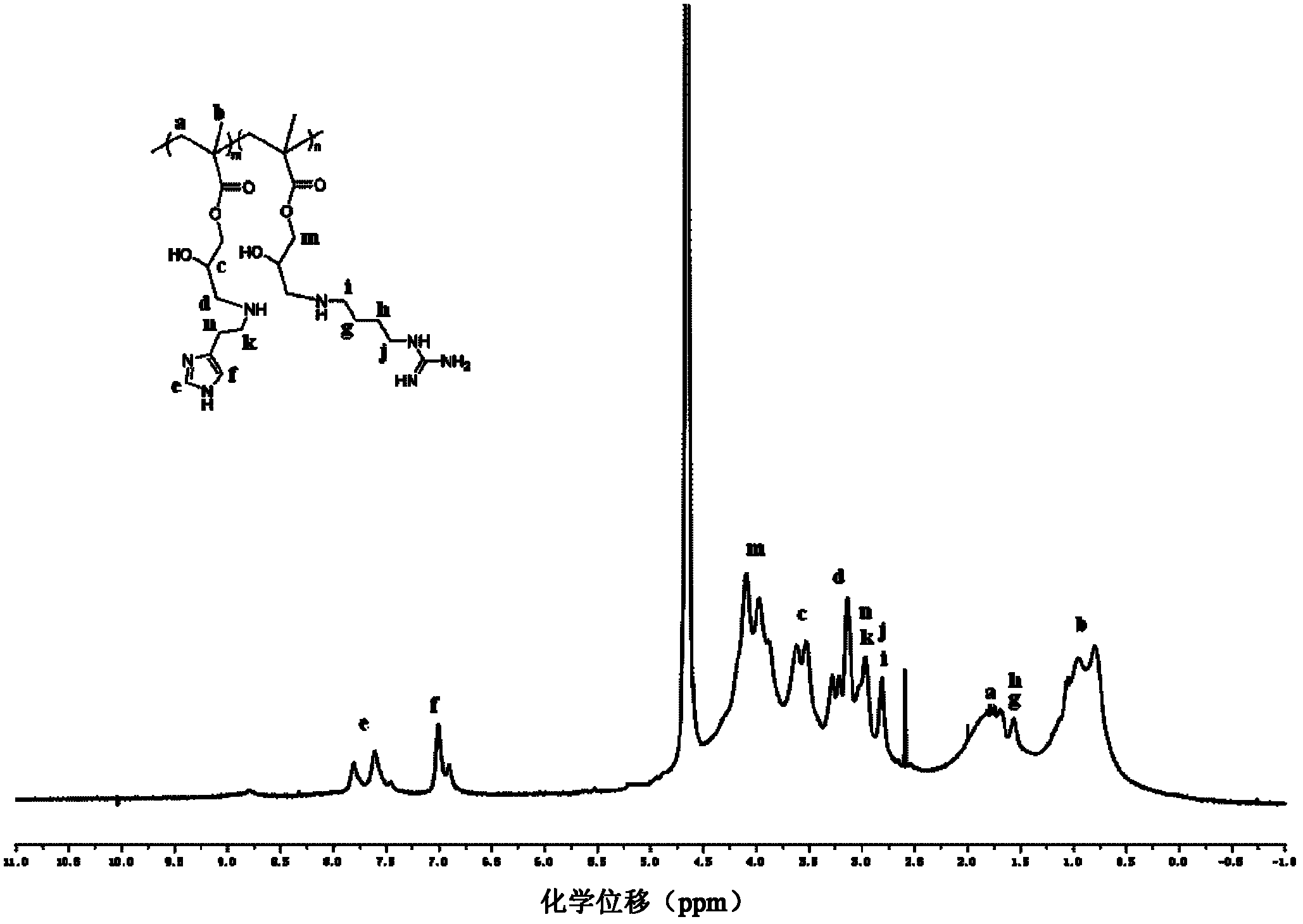Histamine-modified agmatine-based linear-polymer transgenic carrier and preparation method and applications thereof
An arginine-based linear, transgenic vector technology, applied in the field of transgenic vectors and their preparation, can solve the problems of complex escape ability, poor biocompatibility, low transfection efficiency, etc., to increase endosome escape ability , mild synthesis conditions and simple preparation methods
- Summary
- Abstract
- Description
- Claims
- Application Information
AI Technical Summary
Problems solved by technology
Method used
Image
Examples
Embodiment 1
[0027] Get a 50ml round bottom flask, add agmatine sulfate (1.71g, 7.5mmol), histamine dihydrochloride (0.46g, 2.5mmol) and water (10ml) into the flask (ie agmatine sulfate The molar ratio to histamine dihydrochloride is 3 / 1), and stir evenly until it becomes a transparent liquid. About 1 ml of sodium hydroxide solution (4M) was added dropwise to adjust the pH value of the reaction system to about 10. Under vigorous stirring, 1 ml of glycidyl methacrylate (ρ=1.074 g / ml, 7.6 mmol) was slowly dropped into the reaction system, and the reaction was carried out at 35° C. for 24 hours. Extract the reaction solution with ether, collect the lower layer liquid into a 50ml round bottom flask, adjust the pH value of the system to about 5 with 1ml hydrochloric acid solution (4M), add ammonium persulfate (12mg, 0.05mmol) at 65°C under oxygen-free nitrogen Random polymerization under protected conditions for 24 hours. The reaction product was dialyzed in deionized water with a dialysis ba...
Embodiment 2
[0030]Get a 50ml round bottom flask, add agmatine sulfate (1.14g, 5mmol), histamine dihydrochloride (0.92g, 5 mmol) and water (10ml) in the flask (ie agmatine sulfate and The molar ratio of histamine dihydrochloride is 2 / 2), and stir until it becomes a transparent liquid. About 2ml of sodium hydroxide solution (4M) was added dropwise to adjust the pH value of the reaction system to about 10. Under vigorous stirring, 1 ml of glycidyl methacrylate (ρ=1.074 g / ml, 7.6 mmol) was slowly dropped into the reaction system, and the reaction was carried out at 35° C. for 24 hours. Extract the reaction solution with ether, collect the lower layer liquid into a 50ml round bottom flask, adjust the pH value of the system to about 5 with 2ml hydrochloric acid solution (4M), add ammonium persulfate (12mg, 0.05mmol) at 65°C under oxygen-free nitrogen Random polymerization under protected conditions for 24 hours. The reaction product was dialyzed in deionized water with a dialysis bag (molecul...
Embodiment 3
[0033] Get a 50ml round bottom flask, add agmatine sulfate (0.57g, 2.5mmol), histamine dihydrochloride (1.38g, 7.5mmol) and water (10ml) into the flask (ie agmatine sulfate The molar ratio to histamine dihydrochloride is 1 / 3), and stir evenly until it becomes a transparent liquid. About 3ml of sodium hydroxide solution (4M) was added dropwise to adjust the pH value of the reaction system to about 10. Under vigorous stirring, 1 ml of glycidyl methacrylate (ρ=1.074 g / ml, 7.6 mmol) was slowly dropped into the reaction system, and the reaction was carried out at 35° C. for 24 hours. Extract the reaction solution with ether, collect the lower layer liquid into a 50ml round bottom flask, adjust the pH value of the system to about 5 with 2ml hydrochloric acid solution (4M), add ammonium persulfate (12mg, 0.05mmol) at 65°C under oxygen-free nitrogen Random polymerization under protected conditions for 24 hours. The reaction product was dialyzed in deionized water with a dialysis bag...
PUM
 Login to View More
Login to View More Abstract
Description
Claims
Application Information
 Login to View More
Login to View More - R&D
- Intellectual Property
- Life Sciences
- Materials
- Tech Scout
- Unparalleled Data Quality
- Higher Quality Content
- 60% Fewer Hallucinations
Browse by: Latest US Patents, China's latest patents, Technical Efficacy Thesaurus, Application Domain, Technology Topic, Popular Technical Reports.
© 2025 PatSnap. All rights reserved.Legal|Privacy policy|Modern Slavery Act Transparency Statement|Sitemap|About US| Contact US: help@patsnap.com



